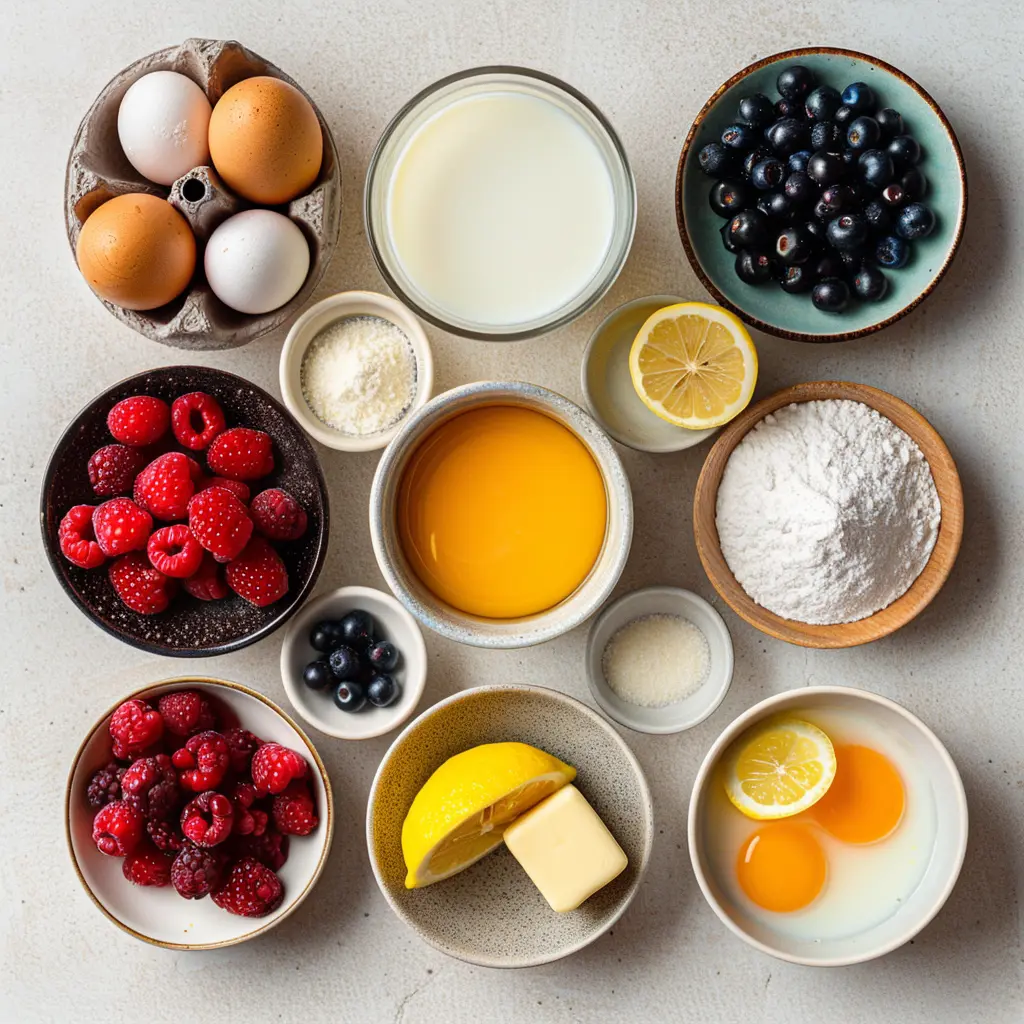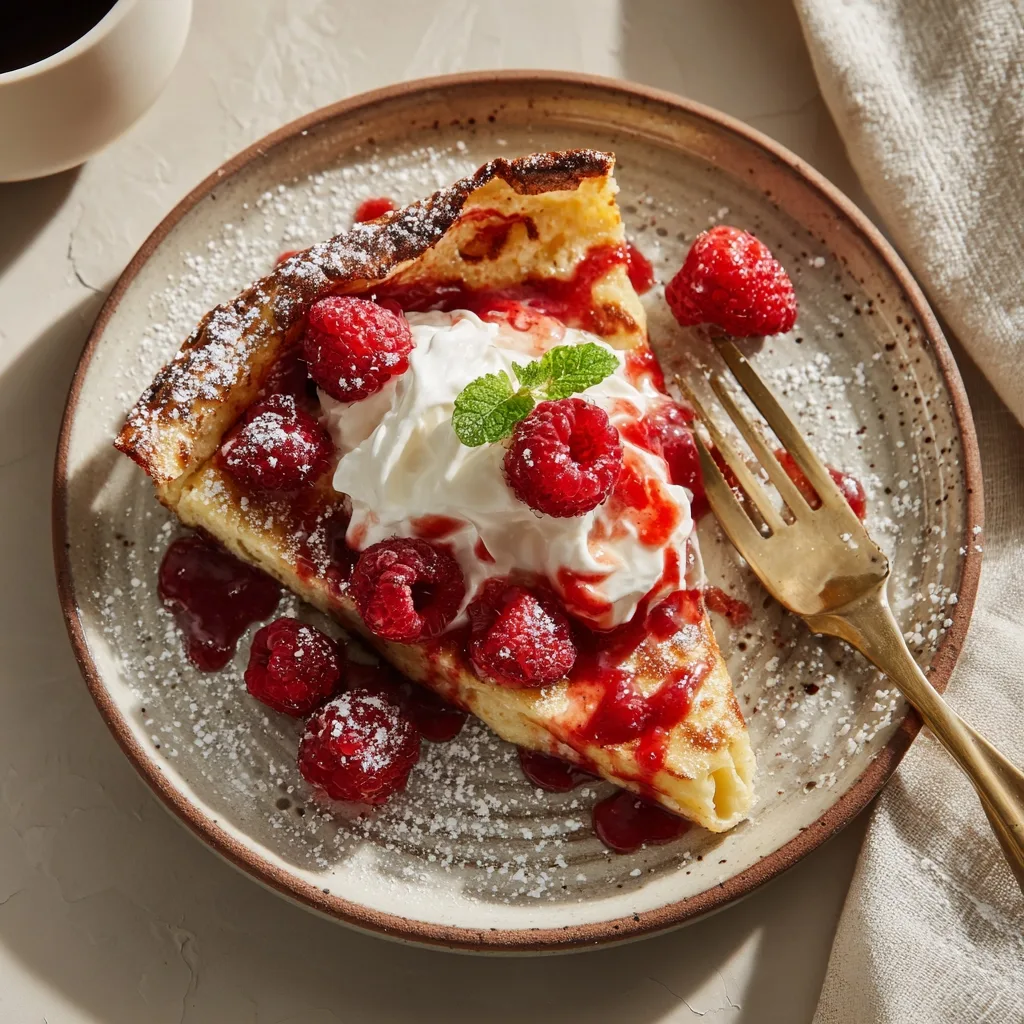A Dutch baby pancake looks dramatic but couldn’t be easier: a simple blender batter, a sizzling hot pan, and the oven does the work. The result is a show‑stopping skillet pancake with deeply crispy edges and a soft, custardy center that cradles fresh berries, maple syrup, strawberry sauce, or whipped cream. If you’ve ever felt chained to the stovetop flipping pancakes, this is your new weekend favorite—no batches, no babysitting, no stress.
This Dutch baby pancake recipe walks you through why the batter puffs, what to do if it doesn’t, how to bake it without a cast‑iron skillet, and the best toppings (sweet and savory). It’s consistent, beginner‑friendly, and endlessly adaptable—great for brunch with friends or a cozy breakfast for two. Once you make it, you’ll see why a Dutch baby pancake belongs in your regular rotation.
Internal links you might want to include up front:
- Try it with bright, quick strawberry sauce and pillowy homemade whipped cream.
- New to baking? Review how to measure flour correctly
- Love brunch? You’ll also enjoy Belgian waffles, swedish pancakes, and delicate crepes.
Why this Dutch Baby Pancake recipe works
The magic of a Dutch baby pancake is steam. Instead of chemical leaveners, a Dutch baby pancake relies on high heat and moisture to inflate dramatically. Here’s why this version delivers consistent lift and that coveted texture:
- Smart ratios: The balance of eggs, milk, and flour creates a thin, custardy batter. Eggs provide structure to trap steam; milk supplies moisture for lift; flour lends just enough body to hold shape without getting heavy.
- Rested batter: A short rest (10–15 minutes) lets flour fully hydrate and gluten relax, ensuring a silky pour, better puff, and a tender, custardy center.
- Hot fat, hotter pan: Preheating the pan with butter guarantees instant sizzle the moment the batter hits, jump‑starting rise and crisping the edges.
- Flexible cookware: No cast iron? No problem. This Dutch baby pancake bakes beautifully in a metal cake pan, ceramic pie dish, or oven‑safe skillet when preheated properly.
- Oven strategy: Start hot to inflate, then finish slightly lower to set the custard center without burning the rim.
Helpful reads to deepen your technique:
- Proper flour measuring prevents dense results.
- Pan material and preheating for Dutch babies and popovers.
- Egg and steam structure in batters.
- Egg safety and doneness guidelines (USDA).
Tip: Want to go savory? Reduce or omit sugar, add herbs or a pinch of garlic powder, and finish with crème fraîche, smoked salmon, or a soft‑yolk egg.
Ingredients of the Dutch Baby Pancake

For one 10–12 inch Dutch baby pancake:
- 3 large eggs, at room temperature
- 2/3 cup (160 ml) milk, at room temperature
- 2/3 cup (80 g) all‑purpose flour
- 1–2 tablespoons granulated sugar (2 for sweet; 0–1 for savory)
- 1 teaspoon vanilla extract (optional for sweet)
- Pinch of fine salt
- 2 tablespoons unsalted butter (for the pan)
Optional finishes:
- Confectioners’ sugar, for dusting
- Fresh berries, sliced fruit, or citrus wedges
- Maple syrup, honey, or warm strawberry sauce
- Softly whipped cream or plain yogurt
- Savory: crème fraîche, smoked salmon, chives, arugula, sautéed mushrooms
Ingredient notes and swaps:
- Flour: Measure by weight for accuracy. If using cups, fluff, spoon, and level. See how to measure flour correctly.
- Milk: Whole milk gives the most custardy center; 2% works too. Non‑dairy options with some fat (oat, cashew) are acceptable but may reduce puff slightly.
- Butter: Don’t skip it; it helps crisp the edges and prevents sticking.
- Pan: A 10‑inch cast iron yields tall edges; a 9‑inch metal cake pan or 10‑inch ceramic pie dish also works well.
Step‑by‑step method
- Preheat the oven and pan
Place a 10–12 inch oven‑safe skillet, metal cake pan, or pie dish on the center rack. Preheat to 425°F (220°C) for at least 10 minutes so the pan gets thoroughly hot. - Blend or whisk the batter
Add eggs, milk, flour, sugar, vanilla (if using), and salt to a blender. Blend 15–20 seconds until smooth and fluid. Alternatively, whisk vigorously until no lumps remain. - Rest the batter (10–15 minutes)
Let the batter stand at room temperature. This short rest improves puff and texture. - Butter the hot pan
Carefully remove the preheated pan, add the butter, and swirl until fully melted and foamy. The butter should sizzle. - Pour and bake
Immediately pour the batter into the center. Return to the oven and bake 16–20 minutes until deeply golden at the rim and inflated. Avoid opening the door early. - Set and serve
If the center looks very loose, reduce the oven to 375°F (190°C) and bake 2–4 minutes more. Serve right away—the tallest puff is fleeting and part of the fun.
Technique boosters:
- See how to preheat pans the right way and correct oven rack positions.
- If you notice uneven browning, rotate the pan in the final 3–4 minutes (quickly to limit heat loss).
Troubleshooting: why a Dutch baby pancake puffs (or doesn’t)
- Cold ingredients: Cold eggs and milk delay steam formation. Use room temperature ingredients.
- Pan not hot: The batter needs instant sizzle to inflate. Always preheat the pan and melt the butter right before pouring.
- Oven peeking: Opening the door too soon dumps heat and collapses the structure. Wait until the rim is golden and firm.
- Batter didn’t rest: Resting improves hydration and reduces gumminess.
- Measurements off: Overpacked flour can weigh down the batter. Review how to measure flour correctly or use a scale.
Normal settling: A dramatic rise followed by a gentle settle in the center is expected. The rim stays crisp; the middle becomes custardy and perfect for toppings.
Serving the Dutch Baby Pancake

A Dutch baby pancake is a blank canvas. Try one of these easy combinations:
Sweet ideas
- Classic: Confectioners’ sugar + lemon wedges
- Berry bliss: Warm strawberry sauce + fresh berries + whipped cream
- Market fruit: Peaches or plums + maple syrup + toasted almonds
- Chocolate‑hazelnut: Cocoa dusting + hazelnut spread + sliced bananas
Savory ideas
- Smoked salmon: Crème fraîche + salmon + chives + black pepper
- Mushroom and greens: Sautéed mushrooms + arugula + shaved Parmesan
- Brunch deluxe: Crispy bacon + soft‑scrambled eggs + chives
Make it a full spread
Storage
A Dutch baby pancake is best fresh, but leftovers can still shine.
- Refrigerate: Cool completely. Store slices in an airtight container up to 2 days.
- Reheat: Oven at 350°F (175°C) for 6–8 minutes on a sheet pan; for crisp edges, preheat the pan first.
- Freezer: Not ideal for peak texture, but you can freeze slices (well‑wrapped) up to 1 month. Reheat from frozen at 350°F (175°C) for 10–12 minutes.
- Food safety: Refrigerate promptly and avoid leaving egg‑rich dishes out for more than 2 hours. See USDA guidance for details.
Related internal helpers:
FAQ
- Can I make a Dutch baby pancake without a cast‑iron skillet?
Yes. A 10‑inch metal cake pan or ceramic pie dish works beautifully. Preheat the pan and melt the butter in it first to mimic cast iron’s sizzle. - Why didn’t my Dutch baby pancake puff?
Most often: cold ingredients, a pan that wasn’t hot, or opening the oven early. Resting the batter 10–15 minutes and measuring flour accurately also helps. Check how to measure flour. - Can I make it dairy‑free or gluten‑free?
Yes, with trade‑offs. Full‑fat non‑dairy milk can work but may reduce puff slightly. For gluten‑free, use a 1:1 baking blend and weigh it; texture will be a touch softer. - How sweet should the batter be?
For a classic Dutch baby pancake, 1–2 tablespoons of sugar is plenty; go toward 0–1 tablespoon for savory versions. - Do I need a blender?
No. A vigorous whisk yields a smooth, lump‑free batter. A blender is simply fast and convenient. - Can I double the recipe?
Use a larger pan (12–13 inches) or two pans on the same rack with some space between them. Increase bake time by 1–3 minutes, watching color and puff. - What are the best toppings?
For sweet: berries, maple syrup, powdered sugar, strawberry sauce, or whipped cream. For savory: smoked salmon, crème fraîche, chives, arugula, mushrooms, or a poached egg. - Why does it deflate when it comes out?
That’s normal. Steam escapes as it cools. Serve immediately to enjoy the tallest rise and crispest rim.
Conclusion
This Dutch baby pancake proves that impressive brunch doesn’t have to be complicated. With a handful of pantry staples, a hot pan, and a short rest for the batter, you’ll get a tall, golden Dutch baby pancake with shatter‑crisp edges and a custardy middle—ready to catch pools of syrup, warm strawberry sauce, or silky savory toppings. Keep your ingredients at room temperature, preheat the pan, and resist opening the oven early. That’s the whole secret.
Save this recipe to your brunch lineup, and use the internal guides on flour measuring, pan preheating, and toppings to make it fail‑proof every time. The Dutch baby pancake is simple, spectacular, and endlessly customizable—exactly what weekend mornings were made for.

